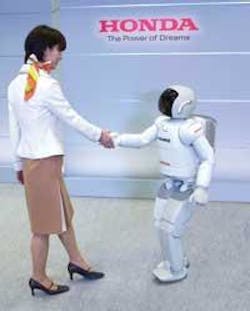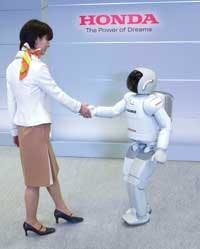Consumers drive robotics developments
Andrew Wilson, Editor, [email protected]
Anyone who has seen videos of ASIMO, the humanoid robot developed by Honda Motor (Tokyo, Japan; world.honda.com/ASIMO), has asked, “When will this technology be available to the consumer and what will be the main applications of such products? At the RoboBusiness conference (Cambridge, MA, USA), Paolo Pirjanian, chief scientist and general manager of Evolution Robotics (Pasadena, CA, USA; www.evolution.com), attempted to answer these questions with a look into the future of the robotics industry.
With more than 350,000 installed robots, Japan is, by far, the leader in deploying conventional robotics systems, according to the International Federation of Robotics (Paris, France; www.isr2004.com). Although Japan accounts for more installations than the USA, Europe, and the rest of Asia combined, the number of units installed there every year is falling as Japanese manufacturers move to off-shore product assembly.
With such an installed base and a large number of companies performing new product development, it appears likely that Japanese companies will retain their advantage in robotics technology. But Pirjanian remains skeptical in regard to the applications in which such technology will be placed. “I would not want an ASIMO in my house,” he quipped at the beginning of his lecture. “There is simply no obvious killer application in the home for such a technology.”
What there is a demand for, it seems, is simpler, less-sophisticated products, for example automated vacuum cleaners such as the Roomba from iRobot (Burlington, MA, USA; www.irobot.com). Even then, Pirjanian points out, the cost constraints of developing these products are enormous. With a $200 retail value, $50 hardware costs, and $10 to $20 for marketing, manufacturing, packaging, and shipping, the manufacturer can only hope for a 2%-4% return.
“Because of this, even sales of more than 1 million units from the time of product launch can be regarded as a failure by traditional consumer-electronics products companies,” Pirjanian says. Robots of the future will not initially resemble Honda’s ASIMO or C3PIO and R2D2 of Star Wars movie fame. “Robots of the future will be marketed in subtle ways,” he says, “as embedded products in automobiles, toys, personal assistants, and other applications.”
Already, the automotive industry is embracing machine intelligence in a number of products, including the lane-departure warning (LDW) system embedded in the Infiniti FX (www.infiniti.com). The LDW system, jointly developed by Nissan Motor (Gardena, CA, USA; www.nissanusa.com) and Valeo (Paris, France; www.valeo.com), is the first production application of the technology in the North American automotive market. The LDW system uses a vision-based camera and proprietary software to monitor the lane markings in front of the vehicle. If a driver makes an unintentional lane departure (without using a turn signal), the system automatically emits an audible warning that alerts the driver to take corrective action. “In this way,” says Pirjanian, “embedded robotics systems will be introduced in incremental steps to the consumer. And, indeed, in the future, it may be that the automobile may become the ultimate robot.”
Similarly, the technology is being embedded in toys such as the AIBO from Sony (Tokyo, Japan; www.sony.net/Products/aibo). “Working with Evolution Robotics, Sony has already deployed a custom version of the company’s ER Vision software in the toy and will work closely with Sony in the development of future products,” says Pirjanian.
Other applications
Evolution is also at work on other applications, such as the company’s LaneHawk loss-prevention system that recognizes supermarket items placed in shopping carts. By digitizing images of oversized items in three dimensions, the LaneHawk processing unit and camera installed in the supermarket’s checkout lane connects to the point-of-sale system over Ethernet connection and acts as a secondary scanner to detect, price, and display items that may otherwise go undetected as the consumer passes through the check-out aisle.
While some who attended Pirjanian’s lecture wondered what such systems have to do with robotics, the lesson was very clear. These technologies will not suddenly appear in sophisticated products such as ASIMO, but rather will evolve from less-sophisticated consumer-based applications. Despite this, Japan’s Ministry of Economy and Industry (Tokyo, Japan; www.meti.go.jp) predicts that humanoid robots will be performing general work in public facilities in Japan by 2018.
Others remain skeptical. “Unfortunately,” Pirjanian says, “there is no Moore’s law for robotics. Future developments depend on a number of disparate technologies and humanoid systems may not appear until 2040.”

